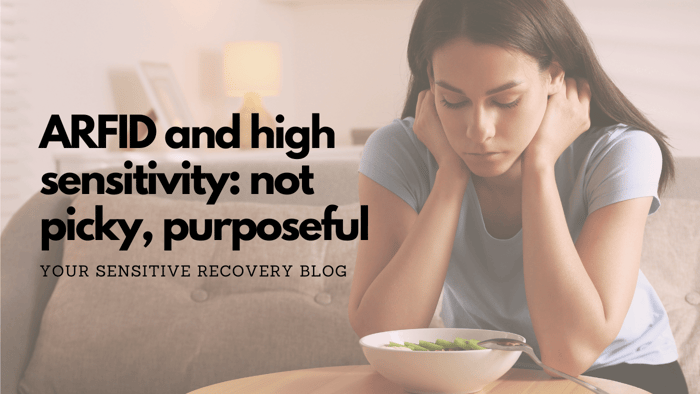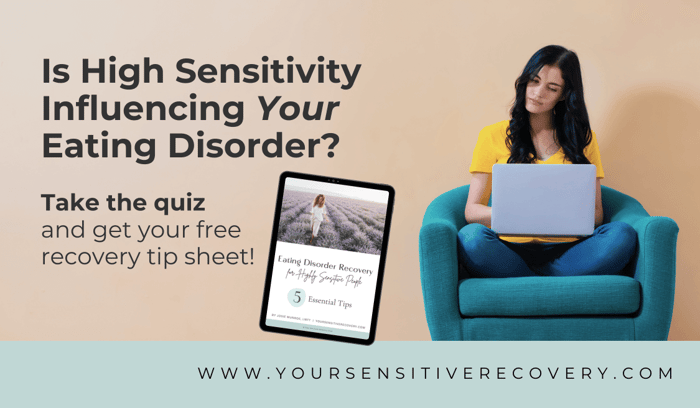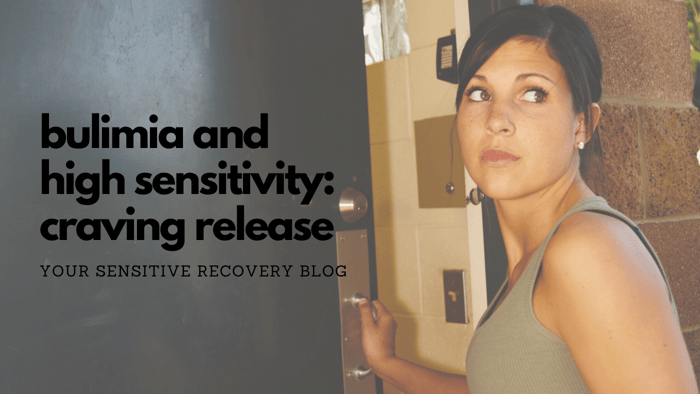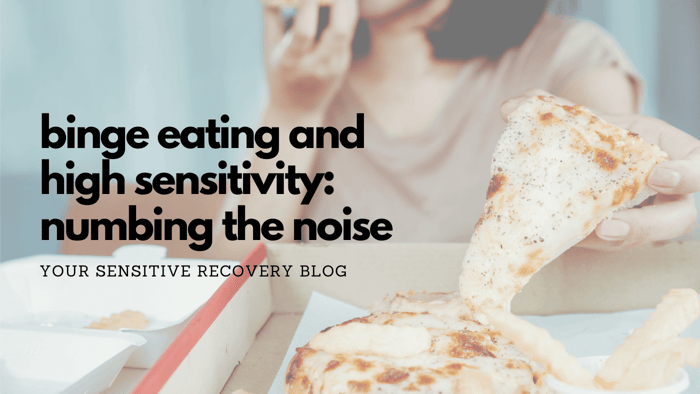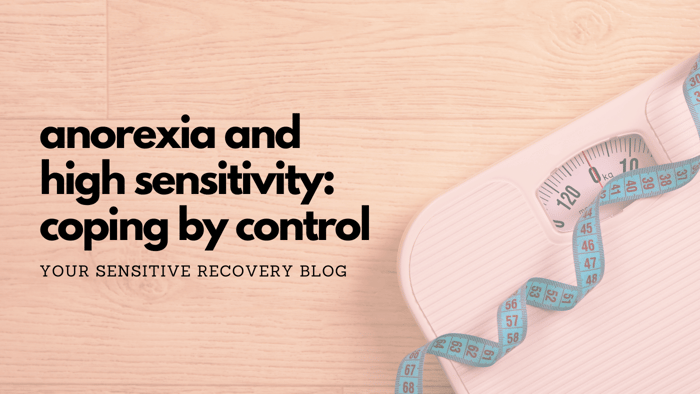Here at Your Sensitive Recovery, I've been diving deep into how High Sensitivity can influence different eating disorders and alter recovery needs. In this post, we’re exploring the challenges that Highly Sensitive People with Avoidant/Restrictive Food Intake Disorder (ARFID) face. Familiar with this eating disorder? Not everyone is, including people who may be dealing with it right now.
Unlike many other eating disorders, ARFID is not about body image but rather sensory and/or fearful responses to past eating experiences.
Because of this, some folks who meet the diagnostic criteria may not recognize that they have an eating disorder because they aren't preoccupied with their weight. But ARFID certainly does manifest in ways that can feel isolating and confusing. For Highly Sensitive People (HSPs), this fraught relationship with food can be even more pronounced and tricky to treat because of the natural HSP characteristics.
But there's good news. With a compassionate and curious mindset, healing can occur in a way that supports the sensory and emotional aspects of recovery and opens you up to a life of true nourishment and peace.
👉 NOTE: While this post focuses on the ARFID diagnosis, the information in this post may also apply to folks with Other Specified Feeding and Eating Disorders (OSFED), or non-diagnosed disordered eating where similar behaviors are present.
The Science of High Sensitivity - What Is It?
HSPs feel more deeply, think more deeply, experience more intensely, and absorb more stimuli from their surroundings.
This "depth of processing" can be a profound gift, allowing for heightened awareness, creativity, and empathy. However, because our nervous systems take in more information, it means we have more to cope with and a greater likelihood of becoming overstimulated. Everyday experiences that others may not think twice about, like strong smells, chaotic environments, or even a breathtaking concerto, can lead to HSPs feeling maxed out.
"It just doesn't seem like anyone else is affected like I am. I'm the only one crying over my new baby niece or plugging my ears at the movie theater." - Danni (36 yrs)When it comes to eating, sensitivities can play a significant role. Some qualities of food can trigger a stronger reaction in HSPs, making eating feel unmanageable.
Understanding the Struggles of ARFID
For those with ARFID, food avoidance isn’t about pickiness or preferences; it’s purposeful and tactical; a response to physical or psychological discomfort. As I mentioned earlier, this eating disorder is not driven by body image concerns or an attempt to cope with stress or emotions through food, as seen in anorexia, bulimia, or binge eating disorder.
Instead, Avoidant/Restrictive Food Intake Disorder presents as a fundamental difficulty with eating itself, whether due to sensory sensitivities, fear-based reactions, or a general lack of interest in food.
These difficulties become labeled as "disordered eating" when they begin to create significant challenges such as unhealthy weight loss, malnutrition, and/or the need for tube feeding.
ARFID is commonly diagnosed in childhood, however, it can also develop in adulthood, often in these cases, triggered by a traumatic food-related experience. Additionally, ARFID is frequently seen in individuals with autism, as sensory processing differences can make certain qualities of food overwhelming, leading to restricted eating patterns. Not all people with ARFID are autistic, but the overlap highlights the role that neurodivergence (including High Sensitivity) can play in the development of the disorder.
ARFID can present in these 3 main ways:
- Sensory Sensitivity: Some people with ARFID experience intense aversions to the taste, texture, smell, or temperature of certain foods. Even seemingly minor variations in food preparation or brand can make the food item feel inedible.
- Fear-Based Avoidance: A frightening or overwhelming experience with food, like choking, vomiting, or having an allergic reaction, can trigger the development of ARFID. The body remembers these moments, and the fear of it happening again can make certain foods feel extremely unsafe.
- Low Interest in Eating: Some individuals who develop ARFID do not experience the hunger drive in the same way others do, leading to a general disinterest in food. Eating may feel like a chore rather than a necessary source of nourishment or a way to experience pleasure.
"It just doesn't feel right. I like the taste...I just take one bite and it's like way too much in my mouth." Patrick (17 yrs)For Highly Sensitive People, these struggles may be even more pronounced. The heightened sensory and emotional processing that comes with High Sensitivity can amplify food-related challenges.
Why Highly Sensitive People May Develop ARFID
For many folks, eating isn’t just about nourishment - it’s a full sensory experience. And as you can imagine, for HSPs, sometimes those experiences can be overstimulating. Because HSPs process stimuli more deeply, a food that seems harmless to someone else may feel unbearably slimy, bitter, or grainy to an HSP, making it difficult to eat a wide variety of foods.
But beyond sensory sensitivities, HSPs also have a strong emotional memory.
Just one negative experience with food, like an intense stomach virus, for example, can leave a lasting imprint. Unlike non-HSPs, who may be able to move on from these experiences more quickly, an HSP’s deep processing can cause food-related anxiety to linger. This can lead to the avoidance of foods that even slightly resemble the ones that caused distress, reinforcing restrictive eating patterns over time.
"I've been terrified of throwing up for as long as I can remember. I know I'm underweight and I don't like it, I just really struggle to eat enough." - Gabe (25 yrs)Additionally, HSPs tend to be more aware of their body’s internal signals like hunger, fullness, and digestion, This is called interoceptive awareness, and while this can be very helpful in many ways, it can also make natural bodily fluctuations feel more intense or unsettling for some individuals. Sensations like mild nausea or bloating after a particular food item may be experienced more intensely, contributing to anxiety around and potential avoidance of more and more foods.
For Highly Sensitive folks with Avoidant/Restrictive Food Intake Disorder, sensory and emotional responses can make a varied and nutrient-dense diet feel nearly impossible. But it's not.
Recovering from ARFID with Sensitivity in Mind
Understanding the connection between High Sensitivity and ARFID can help guide a unique recovery approach that respects sensory needs and the nervous system’s responses to food.
Key Areas to Focus on in Recovery
- Learn About Your Trait: Get to know Sensory Processing Sensitivity, both its challenges and its gifts. This can be so important and validating.
- Define Your Own Progress: Eating behaviors considered "normal" might not be your normal, and that's ok. Be an active participant when creating your recovery goals and defining your movement toward them.
- Make Space for Grief: Acknowledge the pain of living as a sensitive human in an insensitive world, and if applicable, any overly pathologizing treatment experiences that may have attempted to force you into a "neuro-normative" mold.
- Challenge Fear and Avoidance Gently: Exposure therapy with any challenging foods should happen gradually, at your own pace, and only with your complete consent. Small, low-pressure steps can help build confidence without overwhelming your nervous system.
- Strengthen Self-Trust: People with ARFID may have learned to doubt their body’s signals due to familial and societal pressures and general invalidation. Rebuilding trust in your own sensory experiences and cues is essential to long-term healing.
- Build a Support System: Connect with other HSPs for support and educate loved ones about your unique needs. Consider working with a professional who understands both ARFID and High Sensitivity so there's a balance between safety and progress.
There's Nothing Wrong With You
If you see yourself in this connection between High Sensitivity and ARFID, you're not alone, and you're not broken. While sensitivity may have played a role in the development of the eating disorder, it also allows you access to wonderful gifts that can help propel you forward in your healing.
There is space for your differences, your preferences, and your needs.
By developing HSP-friendly tools and learning to embrace your true self, you can find true, deep nourishment, through food and a supportive lifestyle.
You're worth it. 💕
* Names and other identifying details have been changed to protect privacy.
✨ Josie Munroe, LMFT is a licensed therapist and owner of JosieMunroe.com and Your Sensitive Recovery. As a recovered clinician and Highly Sensitive Person, she loves supporting others on their journeys to form new, empowered relationships with food, their bodies, and their sensitivity. Join the newsletter for a weekly boost of hope and inspiration. You deserve a recovery that works for you! ✨

